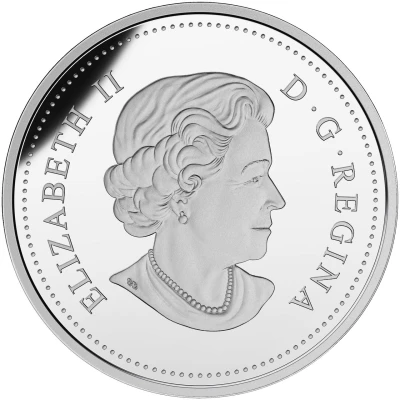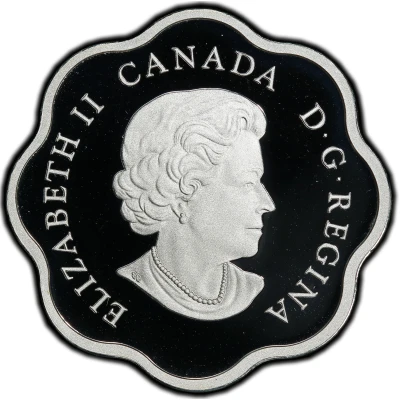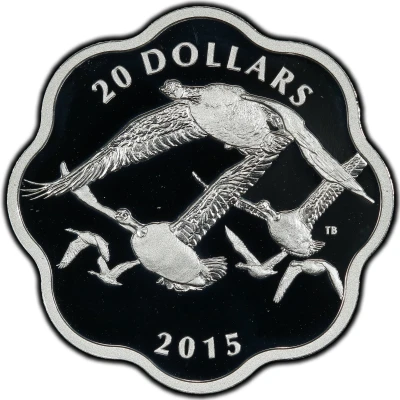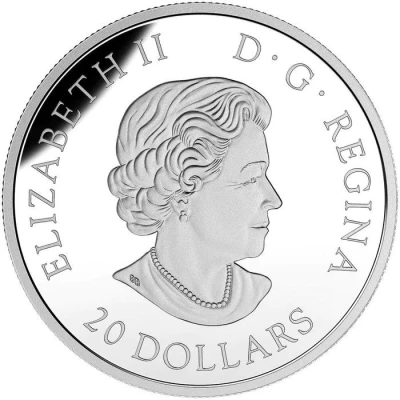
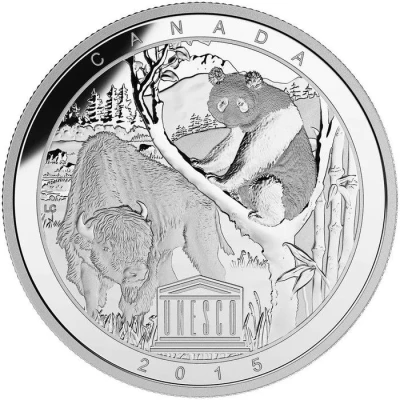

20 Dollars - Elizabeth II Wood Buffalo National Park and Sichuan Giant Panda Sanctuaries
2015 year| Silver (.9999) | 31.39 g | 38 mm |
| Issuer | Canada |
|---|---|
| Queen | Elizabeth II (1952-2022) |
| Type | Non-circulating coin |
| Year | 2015 |
| Value | 20 Dollars 20 CAD = USD 15 |
| Currency | Dollar (1858-date) |
| Composition | Silver (.9999) |
| Weight | 31.39 g |
| Diameter | 38 mm |
| Shape | Round |
| Technique | Milled, Coloured |
| Orientation | Medal alignment ↑↑ |
| Updated | 2024-10-04 |
| Numista | N#378273 |
|---|---|
| Rarity index | 100% |
Reverse
Designed by Canadian artist Lauren Crawshaw, your coin features side-by-side portraits of a bison and a giant panda, each in its own natural habitat. On the left side of the image, a bison stands with its low-slung rump curving behind its massive shoulders.Its shaggy, horned head is lowered as it regards the viewer with its right eye. The bison stands on agrassy plain, its brethren visible in the distance behind it. On the right side of the image, a giant panda is seated in thecrook of a tree, looking at the viewer. Seen from its left side, the panda’s renowned black and white markings are rendered through expert engraving. In the foreground is a stand of bamboo. In the distance behind the panda are the mountains of southeastern China. The two scenes are bisected by thecurving trunk of the tree upon which the panda sits.
Script: Latin
Lettering:
CANADA
20 DOLLARS
2015
LC
Designer: Lauren Crawshaw
Edge
Serrated
Comment
UNESCO, the United Nations Educational, Scientific and Cultural Organization, was founded in 1945. In 1972, it adopted the World Heritage Convention, which lists sites around the world of inestimable natural or cultural value to humanity. Since Canada ratified the Convention in 1976, 17 Canadian sites have been inscribed on the World Heritage List. This captivating new series from the Royal Canadian Mint brings together some of the most extraordinary examples of this heritage, in Canada and around the world, to highlight the similarities between two sites of international importance that are also distinguished by their differences.UNESCO World Heritage Sites are nominated by the countries in which they are located, and are legally protected under a number of agreements, including the Geneva Convention. Chosen for their inestimable value to humanity, these sites are protected by the authorities of the countries in which they are located, and by the 187 countries that have signed the Convention. So, in addition to preserving its own sites on the World Heritage List, Canada is also committed to safeguarding the world's most precious sites.
Wood Buffalo National Park of Canada and the Sichuan Giant Panda Sanctuaries in China are on the UNESCO list. Although their flora and fauna are distinct, these sites share similarities in terms of their importance for natural heritage and for the flagship species that live there.
Wood Buffalo National Park of Canada, in northeastern Alberta, has been on the World Heritage List since 1983. Covering an area of 44,807 square kilometers, it is the largest national park in Canada and the second largest on the planet. It contains the world's largest inland delta, at the mouth of the Peace and Athabasca rivers. The park is also home to unique salt plains and gypsum karsts, a highly representative sample of boreal forest flora, large moss potholes, and the continent's most extensive grass and sedge meadows, not to mention some 46 species of mammals and 227 species of birds. It also boasts the world's largest population of wild bison.
The North American bison (Bison bison) is the continent's heaviest land animal. For millennia, it has dominated most of North America, moving by the tens of millions along ancestral routes in search of food, beaten by millions of hooves and still visible from the air. By the end of the 19th century, European pioneers had over-hunted and exterminated the bison on a massive scale. Their numbers plummeted from several million to just a few hundred. Combined conservation efforts throughout the 20th century have resulted in an increase in the number of wild bison. Wood Buffalo National Park of Canada is an essential link in this conservation effort.
This is the second coin in the Royal Canadian Mint's exciting new series featuring two complementary World Heritage Sites, one in Canada and one abroad.
Did you know that?
- This instantly recognizable black-and-white mammal weighs between 100 and 115 kilograms as an adult. Despite its sedentary lifestyle, it is an excellent climber and swimmer.
- For some, the Giant Panda is a "living fossil", because no other living species on the planet resembles it.
- The Giant Panda has unique six-fingered paws - five fingers and a modified "thumb" which it uses to hold bamboo stalks.
Packaging
The coin is encapsulated and presented in a burgundy double-shell case adorned with the Royal Canadian Mint logo. The case comes with an illustrated protective box.
Interesting fact
One interesting fact about this coin is that it features a unique dual-design, showcasing both the Wood Buffalo National Park in Canada and the Sichuan Giant Panda Sanctuaries in China. This coin was created to celebrate the twinning of these two protected areas, which are home to iconic species such as the wood bison and the giant panda. The coin's design highlights the importance of conservation and cooperation between nations in protecting our natural heritage.
Price
| Date | Mintage | VG | F | VF | XF | AU | UNC |
|---|---|---|---|---|---|---|---|
| 2015 | 2157 | - | - | - | - | - | - |
Values in the table are based on evaluations by sales realized on Internet platforms. They serve as an indication only for 20 Dollars - Elizabeth II (Wood Buffalo National Park and Sichuan Giant Panda Sanctuaries) 2015 coin.
